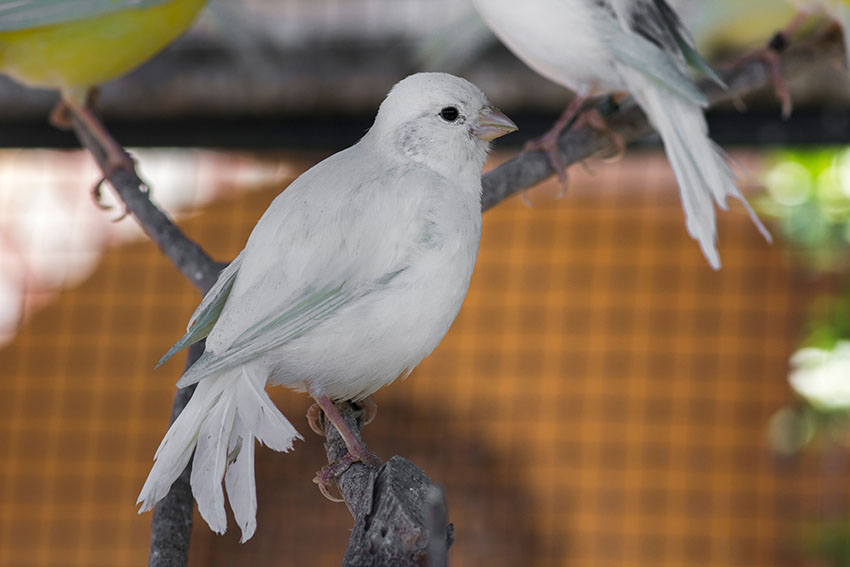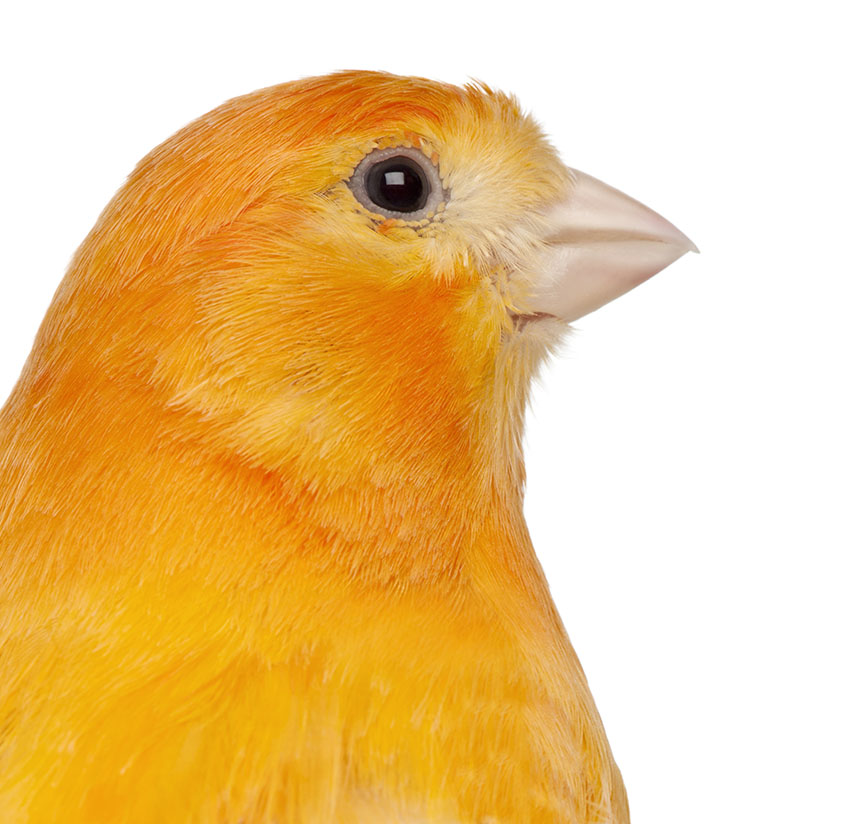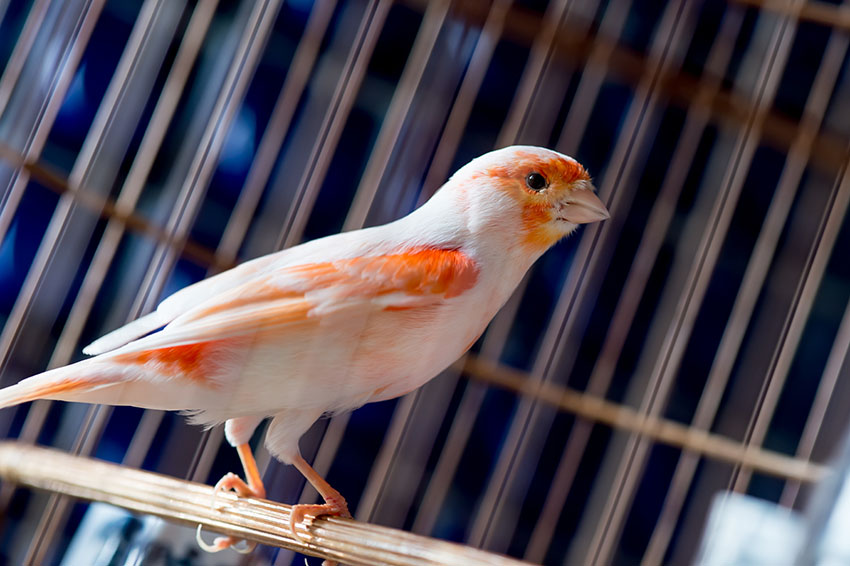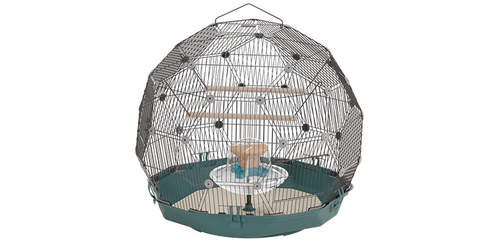Canary Colours
Canaries bred and exhibited on the basis of colour tend to be at the smaller end of the Canary scale, averaging around 140mm (5.5 inches). As in any bird, the colour is controlled by genes responsible for pigmentation. The many subtleties and combinations mean there are dozens of variations on the colour theme, and the key to understanding lies in the palette itself, and the wonderful results of pigmentation (or the lack of it). A wild Canary has three ‘layers’ of colour - an underlying yellow, turned partly green by the brown melanin pigment, and detailed with shades of black melanin.
Different Colour Factors in Canaries
- Melanin. The presence of melanin darkens colours, and in Canaries it is responsible for the blacks and browns. It can be present in varying degrees, and correspondingly different levels of variegation.
- Lipochrome (Ino-Factor). A lipochrome Canary lacks the black and brown ‘layers’, and is stripped back to its base colour. There are three base types amongst pet Canaries – the classic yellow (Lutino), derived from the colour present in the wild Canary; the Red Factor (Rubino), whose rosy tint derives from a genetically imported red pigment, the result of South American Red Siskins being introduced into the gene pool by cross-breeding with Canaries; and white, in which base colour pigments are lacking (Note: most white Canaries are not albinos, which lack pigmentation in their eyes, skin, legs and beak, not just their feathers).
These five factors – black melanin, brown melanin, lipochrome yellow, lipochrome red, and white – are the basis of the endless variations in Canary colour and plumage.

White Canaries
Canary Colour Variegation
The presence of melanin brings great variation to Canary colours and markings. Breeders categorise birds according to levels of this pigment in the following way:
- Clear. These birds have no melanin at all, and therefore no variegation in their colours.
- Self. The opposite to the Clear type, these all-melanin Canaries have no lipochrome colours (yellow or red-based).
- Ticked. These have small, localised patches of melanin.
- Foul. Undoubtedly the least flattering of the many tags given to pet birds, these have a small number of light feathers in their wings or tail, on an otherwise dark coat.
- Variegated. A catch-all category used for anything that falls between ticked and foul Canary types. A ‘lightly variegated’ bird has less than 50% dark feathers; a ‘medium variegated’ is between 50 and 75%; and a ‘heavily variegated’ has in excess of 75% dark coloration – but less than 100%.
Colour Canaries for Shows
In terms of categorisation for show purposes, these are the main groupings of Canaries. (Note: these are not types as such, as many of the categories can apply to yellow or red-based birds, and they can be crested, uncrested, etc.)
- Green (same colours as the wild Canary). These are birds with a yellow base colour and lots of melanin creating greens and blacks.
- Yellow Melanin. These have less pigment than Greens, resulting in a basically yellow bird with dark areas of plumage.
- Red Factor Melanin. These birds are the red versions of the Yellow Melanin, with red instead of yellow as the base colour, along with dark pigmentation.
- Yellow Lipochrome. These are the ‘Tweety Pie’ yellow birds that lots of people automatically associate with Canaries.
- Red Factor Lipochrome. These are birds with no melanin, but with red factor instead of yellow, resulting in shades ranging from pinks and oranges to reds.

Pied red Canary
- Blue Factor. These Canaries have a white or yellow base colour, tinted by a trick of the light (rather than a darkening by melanin). This may sound odd, but birds' feather hooklets often reflect light in such a way as to produce the appearance of colours - the green and purple tinges seen on starlings and magpies, for example. In yellow Canaries the effect is green; in white birds the effect is a blueish grey.
- Silver Factor. These are similar to the Blue factors, but with less melanin, and hence a washed-out, silvery sheen to their feathers.
- Dominant White and Recessive White. These two birds look similar, the differences being in the dominant or recessive nature of their genes. Their feathers lack melanin and lipochrome, resulting in a white bird. They have dark eyes, unlike an Albino bird.
- Pastel Factor. Known as ‘dilute factor’, melanin is reduced in these birds, making the plumage a pastel shade.
- Ivory Factor. Another ‘dilute factor’ type, all pigmentation is reduced in Ivory birds, washing out the colours to varying degrees.
- Opal Factor. Opal Canaries carry two sets of a recessive gene that dilutes melanin, making blacks grey and washing out the browns.
- Cinnamon. Black pigmentation is absent in Cinnamons, which sport browns on a yellow base.
- Fawn. These are like the Cinnamons, but with a white base and not a yellow one.
- Agate. In Agates it is the brown pigment that is lacking, leaving the blacks and greys to colour the bird.
- Isabel. This type has both black and brown pigments at work, but results in birds distinct from standard Green, Yellow and Red types.
- Satinet. These Canaries have localised pigmentation only, on the back and flanks.
- Albino. As in any other animal, an albino Canary lacks all pigmentation. This means white feathers and pink skin, eyes and legs. Due to the complexities of genetics, some albino Canaries (ones with a dominant rather than recessive albino gene) have a hint of yellow about the shoulders and the edges of their flight feathers. They can also have dark instead of pink eyes.
- Ino. These are another reflection of the complexities of genetics, having an essentially albino makeup, but with dark red eyes and some pigments present.
- Phaeo. These Canaries have no blacks or greys present, and their brown pigment is concentrated on the edges of the feathers.
- Onyx. This is a very dark bird with lots of black pigment and no browns to lighten the effect.
- Eumo. These lack brown pigment, as in the Onyx, but the bird has less black pigment, resulting in a much lighter ‘dark’ bird.
- Pied. This general term refers to a bird with areas where the base colour is absent (e.g. white patches behind the yellow or red), and/or with localised splashes of pigment.
- There is also a Dimorphic Factor gene that can complicate the colours by making cocks and hens of each type different.

Pied red Canary
This list isn’t the end of the story, but it covers the basic ground upon which other genetic variations are built.





Comments
Graham, 18 February 2025
TRYING TO FIND A BLUE CANARY
Graeme, 1 June 2021
I am trying to gather some info. on how to breed Onyx canaries, for insertion into my Victorian Canary Club (Australia) newsletter. I understand that these birds are regarded as black canaries. Can you assist me? I thank you in anticipation of your reply. Regards, Graeme Kendrick - President
John, 16 April 2020
I'm trying to find a blue canary
Clare, 7 September 2019
I believe that up to half the offspring of this type of pairing will carry the red factor gene, and that male chicks are more likely to be fertile than females. The easiest way to colourfeed is to mix it into the eggfood, as long as the parents are willing to eat it and feed it to the nestlings. I see you posted several months ago: did you go ahead with the colourfeeding?
Tommy, 10 April 2019
I have a redfactor cock paired to a variegated fife hen would the babies carry the red gene would it be worth my time colour feeding them?